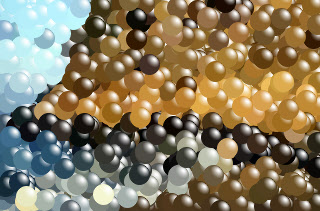LBitmap::ColoredBalls
Summary
Adds colored balls to the bitmap. Various parameters control the color and appearance of the balls.
Syntax
#include "ltwrappr.h"
L_INT LBitmap::ColoredBalls(uNumBalls, uSize, uSizeVariation, nHighLightAng, crHighLight, crBkgColor, crShadingColor, pBallColors, uNumOfBallColors, uAvrBallClrOpacity, uBallClrOpacityVariation, uRipple, uFlags)
Parameters
L_UINT uNumBalls
Number of balls that will be drawn in the image.
L_UINT uSize
Average ball size, in pixels.
L_UINT uSizeVariation
Ball size variation. Valid values range from 0 to 100. Use 0 to have all balls the same size. Use 100 to have the size vary from 0 to 2 X uSize.
L_INT nHighLightAng
Light source direction of the highlight color on the ball. This value is in hundredths of degrees (+/-). A positive value will rotate the highlight color clockwise, while a negative value will rotate the highlight color counter-clockwise. Possible values range from -36000 to + 36000.
COLORREF crHighLight
Highlight color.
COLORREF crBkgColor
Background color.
COLORREF crShadingColor
Shade (or gradient) color.
COLORREF * pBallColors
Pointer to an array of ball colors.
L_UINT uNumOfBallColors
The number of ball colors.
L_UINT uAvrBallClrOpacity
Average ball color opacity. Valid values ranges are:
- 0 to 255 for 8-bit.
- 0 to 4095 for 12-bit.
- 0 to 65535 for 16-bit.
L_UINT uBallClrOpacityVariation
Ball color opacity variation. Valid values range from 0 to 100. Use 0 to have all pixels assigned the same opacity. Use 100 to have the opacity vary from 0 to 2 X uAvrBallClrOpacity.
L_UINT uRipple
The number of shades that are used to produce the background. This value is divided internally by 100. For example, if uRipple = 200 the actual frequency is 2. This value is ignored if the CLRBALLS_SHADING_SINGLE flag is set.
L_UINT uFlags
Flags that indicate which background color, shade (or gradient) type, ball type and ball color type to use. You can use a bit wise OR ( | ) to specify one flag from each group.
The following flags indicate how to draw the shading:
| Value | Meaning |
|---|---|
| CLRBALLS_SHADING_SINGLE | [0x0001] Use only the background color (i.e. no shading). |
| CLRBALLS_SHADING_LEFTRIGHT | [0x0002] Draw shading as vertical lines that move from left to right. |
| CLRBALLS_SHADING_TOPBOTTOM | [0x0003] Draw shading as horizontal lines that move from top to bottom. |
| CLRBALLS_SHADING_CIRCULAR | [0x0004] Draw shading as concentric circles. |
| CLRBALLS_SHADING_ELLIPTICAL | [0x0005] Draw shading as concentric ellipses. |
The following flags indicate how to use the balls:
| Value | Meaning |
|---|---|
| CLRBALLS_STICKER | [0x0010] Use Balls that will overlap like stickers. |
| CLRBALLS_BALL | [0x0020] Use Balls that will adjust like bubbles. |
The following flags indicate how to treat the background:
| Value | Meaning |
|---|---|
| CLRBALLS_IMAGE | [0x0100] Make the background the same as the image. |
| CLRBALLS_COLOR | [0x0200] Make the background using crBkgColor and crShadingColor with the specified shade type. |
The following flags indicate which type of ball coloring to use:
| Value | Meaning |
|---|---|
| CLRBALLS_BALLCLR_MASK | [0x1000] Have the Ball color block image colors. |
| CLRBALLS_BALLCLR_OPACITY | [0x2000] Use the opacity value when combining image colors with ball colors. |
Returns
| Value | Meaning |
|---|---|
| SUCCESS | The function was successful. |
| < 1 | An error occurred. Refer to Return Codes. |
Comments
The CLRBALLS_STICKER flag produces balls with more distinct edges than the CLRBALLS_BALL option.
To update a status bar or detect a user interrupt during execution of this function, refer to LBase::EnableStatusCallback.
This function supports 12 and 16-bit grayscale and 48 and 64-bit color images. Support for 12 and 16-bit grayscale and 48 and 64-bit color images is available only in the Document/Medical toolkits.
If the bitmap has a region, this function works only on the region. If the bitmap does not have a region, this function works on the entire bitmap.
This function does not support signed data images. It returns the error code ERROR_SIGNED_DATA_NOT_SUPPORTED if a signed data image is passed to this function.
This function does not support 32-bit grayscale images. It returns the error code ERROR_GRAY32_UNSUPPORTED if a 32-bit grayscale image is passed to this function.
Colored Balls Function - Before

Colored Balls Function - After

View additional platform support for this Colored Balls function.
Required DLLs and Libraries
- LTIMGSFX
- For a listing of the exact DLLs and Libraries needed, based on the toolkit version, refer to Files To Be Included With Your Application.
Platforms
Win32, x64.
See Also
Functions
- LBitmap::AddNoise
- LBitmap::Emboss
- LBitmap::Mosaic
- LBitmap::MotionBlur
- LBitmap::Oilify
- LBitmap::Posterize
- LBitmap::RemoveRedeye
- LBitmap::Solarize
- LBitmapBase::Underlay
- LBitmap::BumpMap
- LBitmap::Cubism
- LBitmap::Dry
- LBitmap::FreePlaneBend
- LBitmap::FreeRadBend
- LBitmap::GlassEffect
- LBitmap::GlowFilter
- LBitmap::LensFlare
- LBitmap::Light
- LBitmap::Ocean
- LBitmap::PlaneBend
- LBitmap::Plane
- LBitmap::SampleTarget
- LBitmap::Tunnel
- LBitmap::Bending
- LBitmap::Cylindrical
- LBitmap::FreeHandShear
- LBitmap::FreeHandWave
- LBitmap::Impressionist
- LBitmap::Pixelate
- LBitmap::Polar
- LBitmap::Punch
- LBitmap::RadialBlur
- LBitmap::RadWave
- LBitmap::Ripple
- LBitmap::Spherize
- LBitmap::Swirl
- LBitmap::Wave
- LBitmap::Wind
- LBitmap::ZoomBlur
- LBitmap::ZoomWave
- LBitmap::DrawStar
Topics
- Raster Image Functions: Artistic Effects
- Applying Artistic Effects
- Raster Image Functions: Functions Where the Region Preempts the Bitmap
- Raster Image Functions: Modifying Intensity Values
Example
L_INT LBitmap__ColoredBallsExample(){L_INT nRet;COLORREF pBallColors[7];pBallColors[0] = RGB(230,50,50);pBallColors[1] = RGB(230,200,160);pBallColors[2] = RGB(255,255,128);pBallColors[3] = RGB(240,50,100);pBallColors[4] = RGB(255,255,180);pBallColors[5] = RGB(170,240,100);pBallColors[6] = RGB(255,255,255);LBitmap LeadBitmap;nRet =LeadBitmap.Load(MAKE_IMAGE_PATH(TEXT("cannon.jpg")), 0,ORDER_BGR);if(nRet !=SUCCESS)return nRet;nRet =LeadBitmap.ColoredBalls(1000, 25, 15, 4500, RGB(255,255,255), RGB(255,0,0),RGB(255,255,0), pBallColors, 7, 64, 10, 100,CLRBALLS_SHADING_CIRCULAR|CLRBALLS_STICKER|CLRBALLS_IMAGE|CLRBALLS_BALLCLR_OPACITY);if(nRet !=SUCCESS)return nRet;return SUCCESS;}
© 1991-2025 Apryse Sofware Corp. All Rights Reserved.
